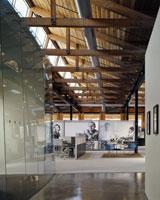
The management of large real estate portfolios used to be equated mostly with leasing strategies, but it’s come to mean a lot more since the 2009 recession rocked everyone’s view of what’s “normal.”
Today, it has as much to do with flexible workplace practices like telecommuting and mobility as it does with flexible leasing actions like going long vs. short, or blending and extending. In either context, it’s all about using less space, cutting costs and increasing operating efficiency.
 As a continuous stream of CoreNet Global research findings over the past 36 or so months shows us, more companies than ever are buying into less traditional workplaces, to the degree that they’re now attracting the attention of mass and trade media outside of corporate real estate (CRE).
As a continuous stream of CoreNet Global research findings over the past 36 or so months shows us, more companies than ever are buying into less traditional workplaces, to the degree that they’re now attracting the attention of mass and trade media outside of corporate real estate (CRE).
In January, the New York Times shed light on how “office space is shrinking,” adding, “that’s not all bad” in relation to some of the more progressive trade-offs employees enjoy with the emergence of more open, collaborative and welcoming work environments.
The Times cited examples of how companies like Intel, AT&T, Deloitte and Sabre Holdings have strengthened the trend. One key reason, as the Times quoted Industry Tracker and CoreNet Global: “Cost has driven traditional companies to free the reins” that once held back wider adoption of what we otherwise call ‘alternative workplace strategies.’
The Mortgage Bankers Association also took note, acknowledging that flexible workplaces go beyond efficiency and extend to effectiveness, reporting in a January MBA Newslink feature that “telecommuting can be effective in retaining talent, increasing productivity and increasing speed to market.”
The publication confirmed Industry Tracker’s January prediction that “companies sitting on cash after cutting costs will now need to reinvest it into product development and the core business.”
We told MBA Newslink, “Cost cutting is under the heading of efficiency, (and) companies can only cut so much before it has an impact on their effectiveness or ability to do business (so that) companies with long-term vision (on flexible workplace practices) looked at it from the viewpoint of effectiveness.”
Re-Engineering Cost Structures
Matt Jackson, managing director inside Jones Lang LaSalle's Strategic Consulting Group, frames this whole discussion around "Reengineering the Cost Structure of the Business."
Why is this type of engineering so important right now? Because it's enabling companies to re-enter a growth and expansion mode even while they continue with aggressive cost-reduction moves. As reported in January by the Wall Street Journal, “big firms (are) poised to spend again.” After hoarding cash during the recession, they are ready to reinvest in growth and expansion again.
But it’s more of a balancing act between cost efficiency vs. growth effectiveness. As a result, "companies are re-engineering the cost structure of the business using key CRE levers like location, portfolio and workplace to improve their operating and profit margins," Jackson points out.
He is advising corporate clients across a spectrum of margin-creation or margin-preservation opportunities, including:
Lease restructuring
Resizing the occupancy envelope
Cluster consolidation
Space supply/demand matching
Shared services
Domestic business process
Offshoring business process
Service center consolidation
Manufacturing footprint consolidation
Distribution center network optimization
Energy spend reduction
Location incentives renegotiation
"The prevailing (client) mentality is lowering structural operating costs and driving efficiencies," Jackson summarizes.
Space Syntax
So companies are again doing more to address growth, and it's a boost to the CRE industry's supply side. That point came across clearly in a recent visit with Margaret Serrato, PhD, MBA, AIA, ASID, LEED® AP, for Herman Miller. She uses Herman Miller's Atlanta showroom as a living case study for a progressive and inviting workplace environment.
Like other supply side people have told me recently about their business trends, Herman Miller's outlook is more upbeat now, Serrato reports.
It's a reflection of corporate client activity increasing, she adds. Economic and cost-cutting pressures have brought more attention to alternative workplace strategies, but so have opportunities to be flexible enough for the next growth trend.
"Companies are ready to talk about the future of work again," Serrato observes. So much that her clients and prospects don't mind hearing her tell them, in many cases, "Your space is holding you back."
She recounts how Winston Churchill once said that "we shape our buildings; thereafter, they shape us." More and more employers are grasping the concept of workplace transformation, in this sense. That's one reason why, "I don't show anybody cubicles anymore," she relates about her analyses and recommendations of various corporate workplace configurations that Herman Miller can deliver for clients.
A big part of Serrato’s focus is space syntax, which she began in her previous role at TVS Design. It's the science of measuring the level of circulation, interaction, human touch points and productivity that more progressive workplace design offers when compared directly against closed, traditional, hierarchical and 'entitled' workspace.
Her current work for clients like National Geographic and Southern Nuclear centers on space syntax, space utilization and sustainability practices.
Serrato’s innovative practice also includes a tool developed by Newmark Knight Frank’s Ann Tucker called "Success Scorecards" that ties back the vision and key goals of any business and measure effectiveness along the lines of human resources, productivity and space.
Up-REITs and Owned, Empty Space
So apart from the corporate services and workplace sides of CRE, there are many other facets to the industry supply chain touching on portfolio optimization. Another big one is the capital markets, as Chris Zlocki, director of consulting, Strategy and Innovation for Colliers International, shares.
The CMBS crisis left the capital investment landscape nearly barren when CRE markets hit bottom in 2009. Now, we’re seeing some encouraging signs of more capital returning to the investment markets. Of course, the post-crash emphasis is on equity, not debt, driven capitalization. The Real Estate Investment Trust industry, comprising about 10 percent of the CRE industry’s funding base, is equity-based and on the upswing. (Too bad REITs don’t represent a larger share of funding right now.)
That’s why Zlocki is enthused about an idea whose time has come known as “Up-REITs.” It’s a hybrid application of the REIT shareholder model through which companies can take unoccupied, owned space and add it to the portfolio of a REIT, which in turn takes the property to market, leases it to alternate tenants, maintains the space, covers operating costs and eventually gives an incremental REIT dividend back to the corporate client.
Zlocki remarks, "This could provide a creative solution” to the problem of excess space, or even moth-balled facilities.


